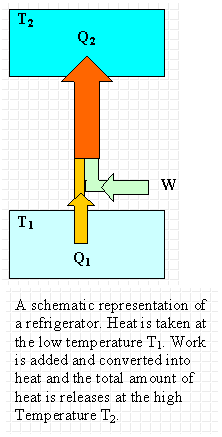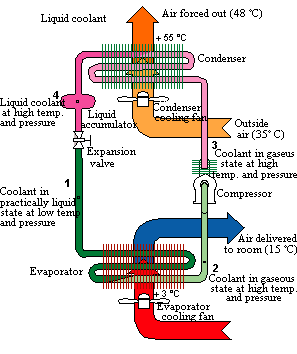Refrigerators, air conditioners, and heat pumps
 Heat cannot, of itself, flow from a cold to a hot object is one way of stating the second
law of thermodynamics. If it could, then heat dumped at Tlow
could just flow back to the reservoir at Thigh and the net
effect would be an amount of heat ΔQ = Qhigh - Qlow
taken at a Thigh and converted into work with no other
changes in the system.
Heat cannot, of itself, flow from a cold to a hot object is one way of stating the second
law of thermodynamics. If it could, then heat dumped at Tlow
could just flow back to the reservoir at Thigh and the net
effect would be an amount of heat ΔQ = Qhigh - Qlow
taken at a Thigh and converted into work with no other
changes in the system.
Assume you want to take heat from a place at Tlow and dump
it at a place with a higher temperature Thigh. You want
to build a refrigerator or an
air conditioner. For
such a device we define the coefficient of
performance COP as the ratio of the amount of heat removed at
the lower temperature to the work put into the system (i.e. the
engine).
COP = Qlow/(-W) = Qlow/(Qhigh
- Qlow).
The best possible coefficient of performance is
COPmax = Qlow/(Qhigh
- Qlow)max = Qlow/(Qlow(Thigh/Tlow)
- Qlow) = Tlow/(Thigh - Tlow),
if we have a reversible engine moving the heat. For a real
engine Qhigh is bigger than QlowThigh/Tlow,
and the coefficient of performance is smaller.
For a refrigerator keeping an inside temperature of 4 oC =
277 K operating in a room at 22 oC = 299 K the best possible
coefficient of performance is COPmax = 277/(299 - 277) =
12.6. The best possible ratio of the amount of heat removed to the
work done is 12.6. Heat cannot flow from inside an ordinary
refrigerator into the warmer room unless we plug in the electric motor
that does work on the refrigerant.
 An air conditioner is a refrigerator whose inside is the room to be cooled (Troom
= Tlow) and whose outside is the great outdoors (Toutside
= Thigh). An air conditioner uses a material
called a "working fluid" to transfer heat from inside of a room to the
great outdoors. The working fluid is a material which transforms
easily from a gas to a liquid and vice versa over a wide range of
temperatures and pressures. This working fluid moves through the
air conditioner's three main components, the compressor, the
condenser,
and the evaporator in a continuous cycle.
An air conditioner is a refrigerator whose inside is the room to be cooled (Troom
= Tlow) and whose outside is the great outdoors (Toutside
= Thigh). An air conditioner uses a material
called a "working fluid" to transfer heat from inside of a room to the
great outdoors. The working fluid is a material which transforms
easily from a gas to a liquid and vice versa over a wide range of
temperatures and pressures. This working fluid moves through the
air conditioner's three main components, the compressor, the
condenser,
and the evaporator in a continuous cycle.
- The working fluid enters the evaporator inside the room as a
low-pressure liquid at approximately outside air temperature.
- The evaporator is typically a snake-like pipe. The fluid
immediately begins to evaporate and expands into a gas. In doing
so, it uses its thermal energy to separate its molecules from one
another and it becomes very cold. Heat flows from the room into
this cold gas. The working fluid leaves the evaporator as a
low-pressure gas a little below room temperature and heads off toward
the compressor.
- It enters the compressor as a low-pressure gas
roughly at room temperature. The compressor squeezes the molecules
of that gas closer together, increasing the gas's density and pressure.
Since squeezing a gas involves physical work, the compressor transfers
energy to the working fluid and that fluid becomes hotter. The
working fluid leaves the compressor as a high-pressure gas well above
outside air temperature.
- The working fluid then enters the
condenser on the outside, which is typically a snake-like pipe.
Since the fluid is hotter than the surrounding air, heat flows out of
the fluid and into the air. The fluid then begins to condense into
a liquid and it gives up additional thermal energy as it condenses.
This additional thermal energy also flows as heat into the outside air.
The working fluid leaves the condenser as a high-pressure liquid at
roughly outside air temperature. It then flows through a
narrowing in the pipe into the evaporator. When the fluid goes
through the narrowing in the pipe, it's pressure drops and it enters the
evaporator as a low-pressure liquid. The cycle repeats.
Overall, heat is been extracted from the room and delivered to the
outside air. The compressor consumes electric energy during this
process and that energy also becomes thermal energy in the outside air.
The maximum coefficient of such an air conditioner is COPmax
= Troom/(Toutside - Troom).
Refrigerators and heat pumps work on the same principle.
A heat pump is a refrigerator whose
inside is the great outdoors and whose outside is the room to be heated. The
coefficient of performance for a heat pump is the ratio of the energy delivered
at the higher temperature to the work put into the system, COP = Qhigh/(Qhigh
- Qlow). The best possible coefficient of performance is
COPmax(heat pump) = (Qhigh/(Qhigh
- Qlow))max
= Thigh/(Thigh - Tlow) = Troom/(Troom
- Toutside)
If the outside temperature is 41 oF = 5oC = 278 K and
room temperature is 77oF = 25oC = 298K then COPmax
= 298/(298 - 278) = 14.9. However, if the outside temperature drops to 14
oF = -10 oC = 263 K then Emax = 298/(298 - 263) = 8.5.
Note: The coefficient of performance for a refrigerator/air conditioner and
the coefficient of performance of a heat pump are defined differently. We
are always interested in how much work we have to do or how much useful energy
we have to invest to accomplish something. For a refrigerator or air
conditioner we are interested in how efficiently heat is removed from the colder
inside for a given amount of work done. For a heat pump we are interested
in how efficiently heat is delivered to the hotter inside for a given amount of
work done. The coefficient of performance gives us those ratios.
External link: The
refrigeration cycle (Youtube)
Problem:
What is the coefficient of performance of a refrigerator that operates with
Carnot efficiency between temperatures of -3 oC and 27 oC?
Solution:
- Reasoning:
For a refrigerator COPmax
= Tlow/(Thigh - Tlow).
- Details of the calculation:
The best possible coefficient of performance is
COPmax
= Tlow/(Thigh - Tlow) =
270/(300 - 270) = 9.
Problem:
A refrigerator has a coefficient of performance equal to 5. If the
refrigerator absorbs 120 J of thermal energy from a cold reservoir in each
cycle, find
(a) the work done in each cycle and
(b) the thermal energy expelled to the hot reservoir.
Solution:
- Reasoning:
For a refrigerator the coefficient of performance is COP = Qlow/(-W).
- Details of the calculation:
(a) COP = Qlow/(-W). (-W) = Qlow/COP = 120/5 J = 24
J.
The work is done on the system. Ordered (electrical) energy is
converted into thermal energy.
(b) (-W) = 24 J = Qhigh - Qlow. Qhigh
=
24 J + 120 J = 144 J.
Embedded Question 2
The energy output of a heat pump is greater than the energy used to operate
the pump. Why doesn't this statement violate the first law of
thermodynamics?
Discuss this with your fellow students in the discussion forum!
 Heat cannot, of itself, flow from a cold to a hot object is one way of stating the second
law of thermodynamics. If it could, then heat dumped at Tlow
could just flow back to the reservoir at Thigh and the net
effect would be an amount of heat ΔQ = Qhigh - Qlow
taken at a Thigh and converted into work with no other
changes in the system.
Heat cannot, of itself, flow from a cold to a hot object is one way of stating the second
law of thermodynamics. If it could, then heat dumped at Tlow
could just flow back to the reservoir at Thigh and the net
effect would be an amount of heat ΔQ = Qhigh - Qlow
taken at a Thigh and converted into work with no other
changes in the system. An air conditioner is a refrigerator whose inside is the room to be cooled (Troom
= Tlow) and whose outside is the great outdoors (Toutside
= Thigh). An air conditioner uses a material
called a "working fluid" to transfer heat from inside of a room to the
great outdoors. The working fluid is a material which transforms
easily from a gas to a liquid and vice versa over a wide range of
temperatures and pressures. This working fluid moves through the
air conditioner's three main components, the compressor, the
condenser,
and the evaporator in a continuous cycle.
An air conditioner is a refrigerator whose inside is the room to be cooled (Troom
= Tlow) and whose outside is the great outdoors (Toutside
= Thigh). An air conditioner uses a material
called a "working fluid" to transfer heat from inside of a room to the
great outdoors. The working fluid is a material which transforms
easily from a gas to a liquid and vice versa over a wide range of
temperatures and pressures. This working fluid moves through the
air conditioner's three main components, the compressor, the
condenser,
and the evaporator in a continuous cycle.